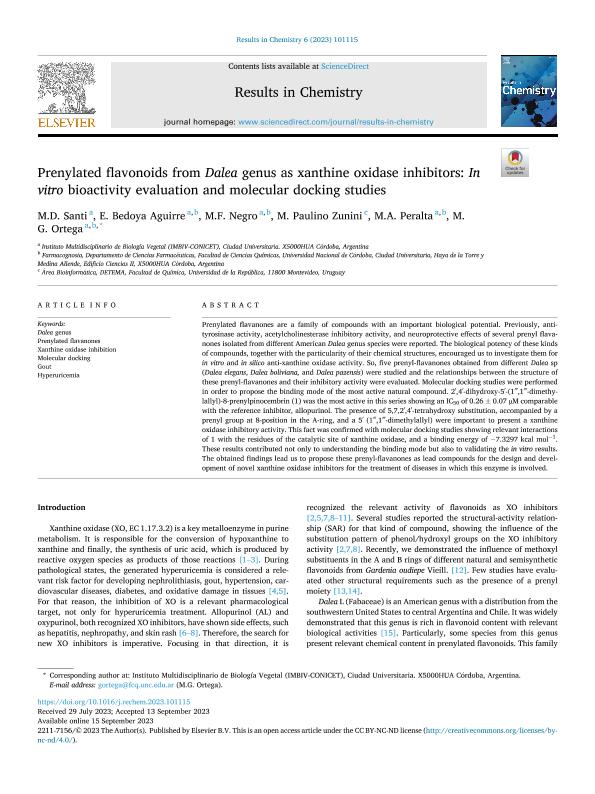Mostrar el registro sencillo del ítem
dc.contributor.author
Santi, María Daniela

dc.contributor.author
Bedoya Aguirre, Einy Nallybe

dc.contributor.author
Negro, Melisa Fabiana

dc.contributor.author
Zunini, M. Paulino
dc.contributor.author
Peralta, Mariana Andrea

dc.contributor.author
Ortega, María Gabriela

dc.date.available
2023-12-15T16:16:46Z
dc.date.issued
2023-12
dc.identifier.citation
Santi, María Daniela; Bedoya Aguirre, Einy Nallybe; Negro, Melisa Fabiana; Zunini, M. Paulino; Peralta, Mariana Andrea; et al.; Prenylated flavonoids from Dalea genus as xanthine oxidase inhibitors: In vitro bioactivity evaluation and molecular docking studies; Elsevier; Results in Chemistry; 6; 12-2023; 1-7
dc.identifier.uri
http://hdl.handle.net/11336/220483
dc.description.abstract
Prenylated flavanones are a family of compounds with an important biological potential. Previously, anti-tyrosinase activity, acetylcholinesterase inhibitory activity, and neuroprotective effects of several prenyl flavanones isolated from different American Dalea genus species were reported. The biological potency of these kinds of compounds, together with the particularity of their chemical structures, encouraged us to investigate them for in vitro and in silico anti-xanthine oxidase activity. So, five prenyl-flavanones obtained from different Dalea sp (Dalea elegans, Dalea boliviana, and Dalea pazensis) were studied and the relationships between the structure of these prenyl-flavanones and their inhibitory activity were evaluated. Molecular docking studies were performed in order to propose the binding mode of the most active natural compound. 2′,4′-dihydroxy-5′-(1‴,1‴-dimethylallyl)-8-prenylpinocembrin (1) was the most active in this series showing an IC50 of 0.26 ± 0.07 µM comparable with the reference inhibitor, allopurinol. The presence of 5,7,2′,4′-tetrahydroxy substitution, accompanied by a prenyl group at 8-position in the A-ring, and a 5′ (1‴,1‴-dimethylallyl) were important to present a xanthine oxidase inhibitory activity. This fact was confirmed with molecular docking studies showing relevant interactions of 1 with the residues of the catalytic site of xanthine oxidase, and a binding energy of −7.3297 kcal mol−1. These results contributed not only to understanding the binding mode but also to validating the in vitro results. The obtained findings lead us to propose these prenyl-flavanones as lead compounds for the design and development of novel xanthine oxidase inhibitors for the treatment of diseases in which this enzyme is involved.
dc.format
application/pdf
dc.language.iso
eng
dc.publisher
Elsevier

dc.rights
info:eu-repo/semantics/openAccess
dc.rights.uri
https://creativecommons.org/licenses/by-nc-nd/2.5/ar/
dc.subject
DALEA GENUS
dc.subject
GOUT
dc.subject
HYPERURICEMIA
dc.subject
MOLECULAR DOCKING
dc.subject
PRENYLATED FLAVANONES
dc.subject
XANTHINE OXIDASE INHIBITION
dc.subject.classification
Otras Ciencias Químicas

dc.subject.classification
Ciencias Químicas

dc.subject.classification
CIENCIAS NATURALES Y EXACTAS

dc.title
Prenylated flavonoids from Dalea genus as xanthine oxidase inhibitors: In vitro bioactivity evaluation and molecular docking studies
dc.type
info:eu-repo/semantics/article
dc.type
info:ar-repo/semantics/artículo
dc.type
info:eu-repo/semantics/publishedVersion
dc.date.updated
2023-12-13T11:23:10Z
dc.identifier.eissn
2211-7156
dc.journal.volume
6
dc.journal.pagination
1-7
dc.journal.pais
Argentina

dc.description.fil
Fil: Santi, María Daniela. Consejo Nacional de Investigaciones Científicas y Técnicas. Centro Científico Tecnológico Conicet - Córdoba. Instituto Multidisciplinario de Biología Vegetal. Universidad Nacional de Córdoba. Facultad de Ciencias Exactas Físicas y Naturales. Instituto Multidisciplinario de Biología Vegetal; Argentina
dc.description.fil
Fil: Bedoya Aguirre, Einy Nallybe. Consejo Nacional de Investigaciones Científicas y Técnicas. Centro Científico Tecnológico Conicet - Córdoba. Instituto Multidisciplinario de Biología Vegetal. Universidad Nacional de Córdoba. Facultad de Ciencias Exactas Físicas y Naturales. Instituto Multidisciplinario de Biología Vegetal; Argentina
dc.description.fil
Fil: Negro, Melisa Fabiana. Consejo Nacional de Investigaciones Científicas y Técnicas. Centro Científico Tecnológico Conicet - Córdoba. Instituto Multidisciplinario de Biología Vegetal. Universidad Nacional de Córdoba. Facultad de Ciencias Exactas Físicas y Naturales. Instituto Multidisciplinario de Biología Vegetal; Argentina
dc.description.fil
Fil: Zunini, M. Paulino. Universidad de la República; Uruguay
dc.description.fil
Fil: Peralta, Mariana Andrea. Consejo Nacional de Investigaciones Científicas y Técnicas. Centro Científico Tecnológico Conicet - Córdoba. Instituto Multidisciplinario de Biología Vegetal. Universidad Nacional de Córdoba. Facultad de Ciencias Exactas Físicas y Naturales. Instituto Multidisciplinario de Biología Vegetal; Argentina
dc.description.fil
Fil: Ortega, María Gabriela. Consejo Nacional de Investigaciones Científicas y Técnicas. Centro Científico Tecnológico Conicet - Córdoba. Instituto Multidisciplinario de Biología Vegetal. Universidad Nacional de Córdoba. Facultad de Ciencias Exactas Físicas y Naturales. Instituto Multidisciplinario de Biología Vegetal; Argentina
dc.journal.title
Results in Chemistry
dc.relation.alternativeid
info:eu-repo/semantics/altIdentifier/doi/http://dx.doi.org/10.1016/j.rechem.2023.101115
dc.relation.alternativeid
info:eu-repo/semantics/altIdentifier/url/https://www.sciencedirect.com/science/article/pii/S2211715623003545
Archivos asociados
